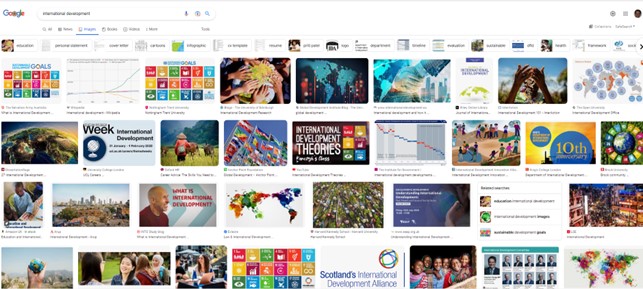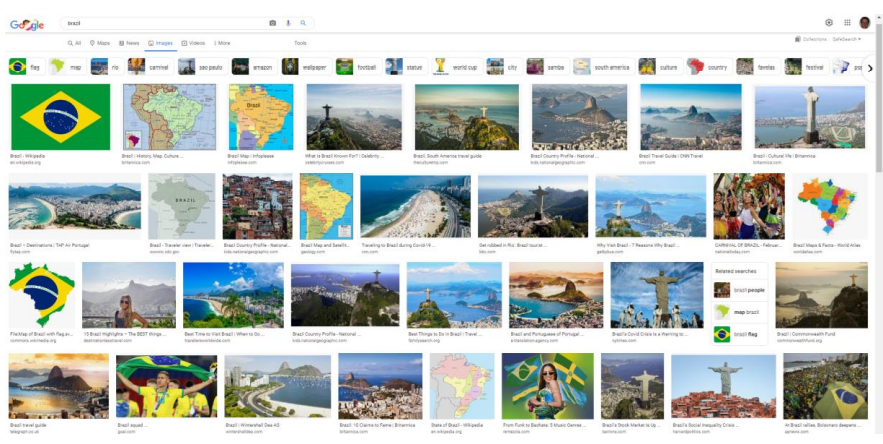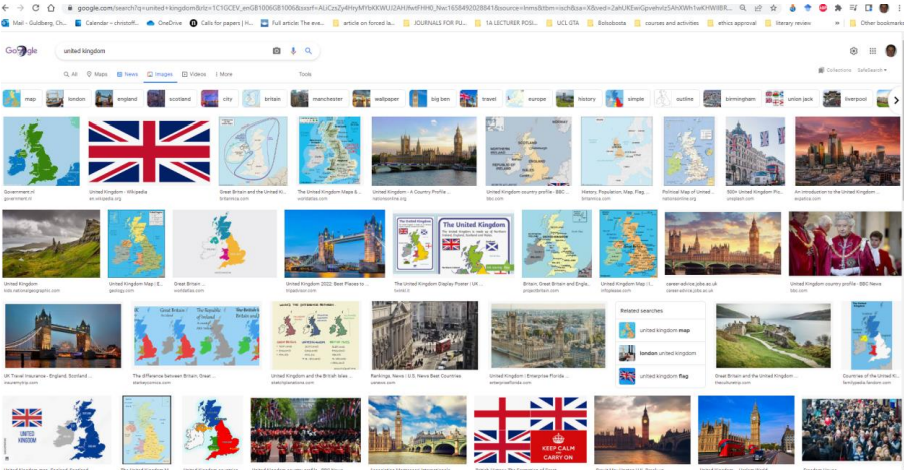
This case study is authored by Christoffer Guldberg, and builds on his article, Using Google Images, Maps and Earth to teach critical thinking – Decolonising the curriculum and beyond, as published in the Journal of PGR Pedagogic Practice. Christoffer is currently a lecturer in political science at Dauphine PSL, and holds a joint degree Ph.D. from King´s and the University of São Paulo’s International Relations Institute.
What is it?
This blog post is about a method for visualizing the coloniality of international relations, the war on drugs, international development, and beyond. It sums up a larger, peer-reviewed article published in the Warwick Journal of Postgraduate Pedagogic Practice. In this article I outline a method of decolonial education that I have developed based on my teaching in Brazil on the global war on drugs (Guldberg, 2022). I have used this method inter alia in a guest lecture for first and second-year students in the history and politics of Latin America to introduce the concept of the Latin American nation, as imagined, and to second-year students in a seminar for the course, Development Geographies – livelihoods and policy context, to problematise the concept of “international development” as a practice that reinforces unequal power relations.
In its simplest form, this method uses Google Images to show how apparently neutral political, legal and scientific concepts are constructed in practices of policing, online searches, and international development according to such social, legal, and political categories as drugs, race, gender, or nationality.
For example, this method can be applied to such different concepts as “drug trafficker”, ”international development” and individual countries, such as ”Brazil”, ”The United Kingdom”, ”Nigeria” or ”The United States”. However, this activity can also be used to teach topics in social science disciplines and with some modifications, might be applicable to the life sciences, social work, and medicine, where it is relevant for practitioners to understand how images of the healthy body shape health-seeking practices.
Why do it?
The recent decade has seen a push towards decolonising the curriculum in order to ensure more representation of authors with backgrounds that are not white and/or Western European. However, if this change is not followed up by a decolonisation of the teaching situation, it risks becoming a form of box-ticking, serving to superficially relieve the university of responsiblity while not giving rise to more profound and lasting changes in and beyond academia (Foluke Adebisi, 2020). Therefore, decolonisation needs to go beyond the curriculum towards developing specific, practical ways of decolonising the teaching situation and the university as a space for production of knowledge, and a locus of power (Sabaratnam, 2017).
This political objective of decolonisation is also closely related, if not inseparable from, the pedagogical method and aim of allowing students to learn in an interactive way drawing from technologies that they know from their everyday lives to themselves discover how these reproduce coloniality (Freire, 2000; Quijano, 2000). Thus, decolonial thinking is partly about questioning colonial institutions and the concepts that structure them. In this sense it is a form of critical theory, according to Cox’s definition. If this is the case, students should also be able to take this method with them beyond the classroom to think critically about the concepts that shape their professional and private lives and practice. This should be further facilitated by how the multi-modal and interactive nature of this exercise facilitates memorisation and further practical application (Lee et al., 2019).
In the original article I further outline how my method can be used to teach students about the challenges to global environment governance, including by drawing on Google Earth (Guldberg, 2022), but, as mentioned above, the method is applicable beyond this, subject to the level of the students, and – mainly -the imagination of the teacher.
How to set it up
The method consists of asking students to do a Google Image search for one or more of these concepts and guiding/supporting them to analyse how results are gendered and racialised. Depending on the level of the students, it is important first to explain how race and gender are social constructs. The simplest way to explain this is by drawing on the concept of social facts, that is, race and gender are social facts because people act according to them as if they were real (biological) facts. However, the complexity of this can be adjusted to different levels, while adding appropriate empirical examples to aid students understanding. For example, the criminalisation of drugs occurs on the primary and secondary levels, meaning that while the primary level is in contemporary societies formally neutral regarding race, it is on the secondary level, when police officers and judiciaries filter who is arrested and punished, that the race of suspects and defendants defines who is seen as a “criminal” (Eugenio Raul Zaffaroni, 2013).
Other examples of the devastating real-life effects of the social fact of race is the well-known policies of divide and conquer in colonized societies, such as those separating Hutus and Tutsis in Rwanda. Such policies have long-term effects, in part because people come to see ethnicity as real, and act accordingly, including by entrenching and performing ethnicities for political economic, or social purposes, as in the case of ethnic entrepreneurs. For a pedagogical example of this latter concept, the BBC series, the Death of Yugoslavia can be shown to students. Two parts of episode 1 – Enter Nationalism, in particular, provide vivid examples of the role of ethnic entrepreneurs in fomenting violence, namely: from 5:30 to 7:30 Milosevic’s talks with Serb nationalists, and performances in TV-productions and other forms of cultural memory of the victimisation of Serbs. The part from 8:50 till 14:09 shows how this narrative is performed in community meetings in claims of atrocities committed by Muslim Albanians against Christian Serbs.
Drawing on such empirical examples, search results can then form the basis for a discussion on the classroom, informed both by students experiences as coming from different ethnic, national and cultural back grounds, as well as the weekly readings and the knowledge of the seminar leader.
The example illustrating this post (Figure 1, top of page) shows the Google Image search results for the search term ”international development”. The Google Image search of this concept clearly reveals several problematic power relations that students should be able to identify by themselves or with some guidance.
Thus, in Figure 1 we clearly see several aspects of international development as Google’s algorithm, aggregating thousands of individual searches, associates this concept with different racialised bodies, world regions and institutions. What is striking here is how ”international development” takes an unequal form between the passive recipients of development represented by Black and Brown people, particularly children, whereas agency and expertise is situated in Western universities and organisations such as the University of Edinburgh, King’s College London (KCL), Harvard Kennedy School of Government, University College London (UCL) and London School of Economics and Politics (LSE).
The suggested searches, further show how degrees from these institutions can lead to a career in international development with suggestions such as ”cover letter”, ”CV template” and ”personal statement”.
Such observations should lead to students questioning both the concept of international development and their own current and future roles as global citizen directly or indirectly engaged in this sphere, leading to fruitful discussion on encountering ”development” as more than an abstract concept, but a practice that is shaped by unequal relations of power (Escobar, 2012).
The method can equally be applied to legal, economic and political concepts such as ”drug trafficker”, to show how concepts that inform public panics and state-sponsored violence, are shaped in practices of racialisation whereby the legal and economic categories of ”drug trafficker” and ”drug user” or the socio-legal category of ”drug addict”, serve to control specific bodies in racialised forms of policing and sensationalist journalistic reporting (Saad, 2019).
Nation states, as imagined communities, that are also imagined from the outside, as object of neo-colonial desire can also inform this exercise. As an example, below we see the Google Image search for Brazil and the United Kingdom.


There are some striking differences between the two results, most notably the almost complete absence of political symbols in the case of Brazil, other than the map and the flag. Instead, we see cultural tourist attractions to be ”consumed”, including sexualised, ”racy” women who have, since the military dictatorship, been promoted as a Brazilian ”attraction” (Santos et al., 2021; Schuinski, 2021)
In contrast, in the case of the UK, symbols of political statehood abound, whether this be parliament or Queen Elizabeth. In other words, the institutions that allow for the UK to enter into relations with other nations on an equal footing, a opposed to being the object of desire and consumption.
This difference serves as a visual representation to students of the limits to political community that deny the postcolonial subject their access to the international (Jabri, 2012). To make this exercise more relevant the teacher can ask students to Google a country they have a personal connection to or are otherwise interested in. This should show how countries, both in the Global North and South are performed and imagined online in different ways that relate to their histories and places in a global political economy.
References
Escobar, A. (2012). Encountering Development. In Encountering Development. https://doi.org/10.1515/9781400839926
Eugenio Raul Zaffaroni. (2013). Organized Crime: A Frustrated Category. In E. R. Zaffaroni & E. Oliveira (Eds.), Criminology and Criminal Policy Movements. RowmanLittlefield.
Foluke Adebisi. (2020). Decolonisation Is Not About Ticking a Box: It Must Disrupt. Critical Legal Thinking.
Freire, P. (2000). Pedagogy of the Oppressed. Bloomsbury Academic.
Guldberg, C. (2022). Using Google Images, Maps and Earth to teach critical thinking: decolonising the curriculum and beyond. Journal of PGR Pedagogic Practice, 2(2), 61–78. https://doi.org/10.31273/jppp.vol2.2022.1231
Lee, K., Dabelko-Schoeny, H., Roush, B., Craighead, S., & Bronson, D. (2019). Technology-Enhanced Active Learning Classrooms: New Directions for Social Work Education. Journal of Social Work Education, 55(2), 294–305. https://doi.org/10.1080/10437797.2018.1540322
Quijano, A. (2000). Coloniality of Power and Eurocentrism in Latin America. International Sociology, 15(2), 2015–2232.
Saad, L. (2019). “Fumo de negro” : a criminalização da maconha no pós-abolição. EDITORA DA UNIVERSIDADE FEDERAL DA BAHIA.
Sabaratnam, M. (2017). Interview – Meera Sabaratnam. E-INTERNATIONAL RELATIONS, March, 1–5. https://www.e-ir.info/2017/03/09/e-ir-interview-meera-sabaratnam/
Santos, D. B. M. dos, Francisco, C. N. P., & Guerra, J. R. F. (2021). A representação da mulher no turismo brasileiro: uma abordagem discursiva atual (2019-2020). Revista Turismo Em Análise, 32(1), 141–161. https://doi.org/10.11606/issn.1984-4867.v32i1p141-161
Schuinski, R. M. (2021, March). Google image search cements national stereotypes of ′racy′ women. DW. https://www.dw.com/en/google-image-search-cements-national-stereotypes-of-racy-women/a-56767605

Leave a Reply